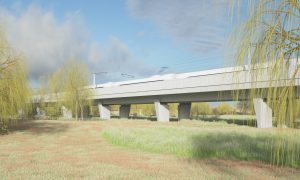The Edgcote Viaduct has had its carbon footprint cut by more than 13% in comparison to the previous design. The viaduct is set low into the landscape of west Northamptonshire, and at 515m-long will carry trains across the floodplain of the River Cherwell, south of Chipping Warden.
It is one of more than 50 major viaducts being built as part of the HS2 project, which is designed to free up space on the most crowded part of the existing west coast mainline and drive growth across the UK.

To achieve the carbon saving, engineers adopted the same pioneering approach developed for the Thame Valley Viaduct, near Aylesbury. This lighter weight, modular design cuts the amount of concrete and steel in the design and will be manufactured off site at a facility in Kent.
Instead of five beams per span, secured with concrete poured in situ, the team will use just two larger ‘u’ shaped beams per span, secured directly to the next pair of beams. While not significantly changing the height or length of the viaduct, this structural change will reduce the number of lorry movement and speed up construction.
At between six and eight meters high, the viaduct will be supported by 20 pairs of pre-cast concrete piers. From a distance, it will be largely hidden by existing hedgerows and woodland.